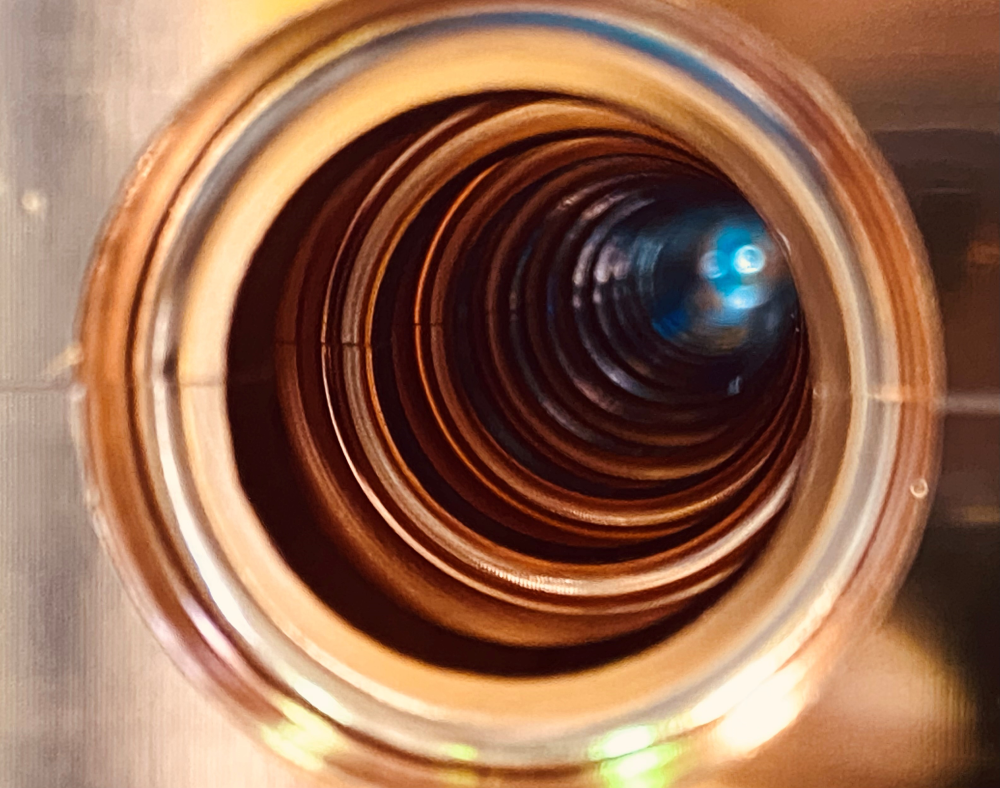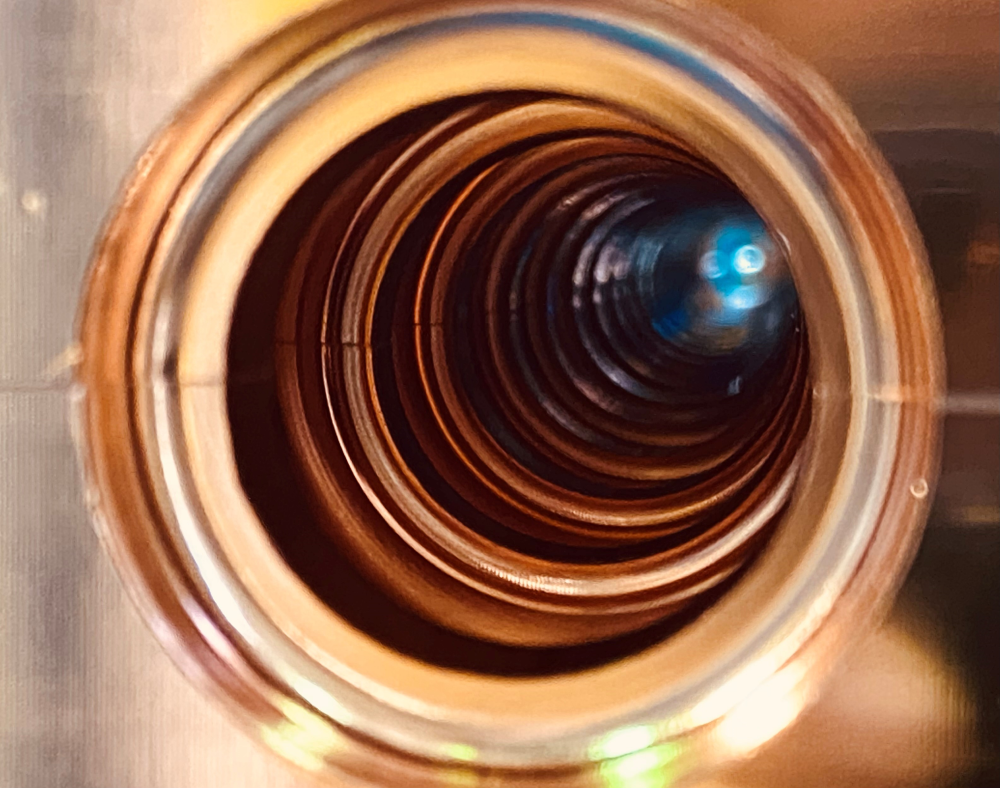A “Retro” Collider Design for a Higgs Factory
In July, particle physicists in the US completed the Snowmass process—a decadal community planning exercise that forges a vision of scientific priorities and future facilities. Organized by the Division of Particles and Fields of the American Physical Society, this year’s Snowmass meetings considered a range of plans including neutrino experiments and muon colliders. One new idea that generated buzz was the Cool Copper Collider (or C3 for short). This proposal calls for accelerating particles with conventional, or “normal-conducting,” radio frequency (RF) cavities—as opposed to the superconducting RF cavities used in modern colliders. This “retro” design could potentially achieve 500 GeV collision energies with an 8-km-long linear collider, making it significantly smaller and presumably less expensive than a comparable superconducting design.
The goal of the C3 project would be to operate as a Higgs factory, which—in particle-physics parlance—is a collider that smashes together electrons and their antimatter partners, called positrons, at energies above 250 GeV. Such a facility would make loads of Higgs bosons with less of the mess that comes from smashing protons together—as is done at the Large Hadron Collider (LHC) in Switzerland. A Higgs factory would give more precise measurements than the LHC of the couplings between Higgs bosons and other particles, potentially uncovering small discrepancies that could lead to new theories of particle physics. “I think the Higgs is the most interesting particle that’s out there,” says Emilio Nanni from the SLAC National Accelerator Laboratory in California. “And we should absolutely build a machine that’s dedicated to studying it with as much precision as possible.”
But an outsider might wonder why another Higgs-factory proposal is being added to the particle-physics menu. A similar factory design—the International Linear Collider (ILC)—has been in the works for years, but that project is presently stalled, as the Japanese government has not yet confirmed its support for building the facility in Japan. Waiting in the wings are several other large particle-physics proposals, including CERN’s Future Circular Collider and China’s Circular Electron Positron Collider.
What sets C3 apart is its choice of normal-conducting RF cavities for accelerating particles, whereas most machines these days rely on superconducting RF cavities. Each system has its merits, with normal conductors being better accelerators and superconductors being more energy efficient. The fact that physicists are now weighing these technologies against each other is a bit of déjà vu, as the preliminary design work for the ILC pitted a superconducting option against a room-temperature, normal-conducting one. In 2004, the particle-physics community decided to go with superconductors for the ILC. “The superconducting approach was more mature and lower risk,” Nanni says. But over the past decade, normal-conducting technology has gotten better. In particular, researchers have managed to more than triple the acceleration gradients that propel charged particles along a beamline.
The recent improvements in normal conducting technology have stemmed from a better understanding of “breakdown”—an unwanted electric discharge emitted from the copper cavity walls. To avoid breakdown, collider operators have traditionally been forced to limit their acceleration gradients to around 70 MV/m. But in the early 2000s, researchers discovered a connection between breakdown and heat-induced defects, and that realization has led to a new way to avoid breakdown: chill the copper walls down to 80 K. Copper at this low temperature has a higher conductivity, which reduces the resistive heating that causes defects. Preliminary experiments showed that cool copper and other cavity design improvements allow field strengths as high as 250 MV/m without breakdown. “The gradients you can get are really incredible,” Nanni says.
These developments inspired several physicists to resurrect the idea of a normal-conducting linear collider. “With no good news coming out of Japan, we decided to start running the numbers for how long the machine would need to be and how much it might cost,” says Caterina Vernieri from SLAC. She and other colleagues sketched out an 8-km-long collider that could generate gradients as high as 120 MV/m. The machine would operate initially at an energy of 250 GeV but then later upgrade to 550 GeV. For comparison, the ILC—with its planned gradient of 31 MV/m—would need to extend for 30 km to reach 500 GeV. Many factors go into the cost of a machine, but the price tag generally scales with the length, Nanni says. The researchers offered up the C3 idea for consideration at Snowmass. “We felt like it was a compelling opportunity that we wanted to present to the community,” Vernieri says. “And it got traction.”
“A lot still needs to be demonstrated, but C3 promises to compare very favorably with other more mature projects and could be realistically hosted in the US,” says Laura Reina from Florida State University. Reina was one of the conveners of the Energy Frontier group at Snowmass, which evaluated future projects for studying the Higgs and other heavy particles. The next step for C3 is to perform a 9-m-long experiment that would demonstrate that the technology won’t present any surprises as long stacks of cool copper cavities are connected together. Funding for that demonstrator project will be considered by the Particle Physics Project Prioritization Panel, which will finalize the “wish list” that US particle physicists will send to Congress in 2023.
“Two important aspects of C3 that are very exciting are its ability to reduce the cost and also the time to build a Higgs Factory,” says Meenakshi Narain from Brown University, who is another Snowmass convener. She thinks that the C3 proposal helped to “reinvigorate the community,” especially by encouraging the participation of early-career physicists. Vernieri is in this early-career group. “The physicists of my generation are eager to understand what the future is beyond the LHC, and whether we’re going to have a machine,” she says. Vernieri is advocating C3, but she’d be happy with ILC or another project. “I would love to have a Higgs factory, whatever that would be.”
Correction (11 October 2022): The original story incorrectly stated that the LHC smashes protons and antiprotons, when in fact that machine collides two proton beams.
–Michael Schirber
Michael Schirber is a Corresponding Editor for Physics Magazine based in Lyon, France.





